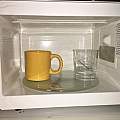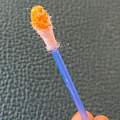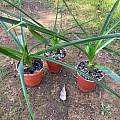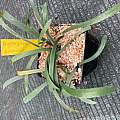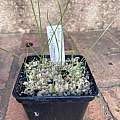by Johannes-Ulrich Urban, Monchique, Portugal, Jan 29th, 2022
A single bulb of Albuca clanwilliamae-gloria which produced two flowering scapes in May 2021 served as stock plant for the described experimental approach to produce viable seeds.
Background
Origin of stock bulb: The bulb was raised from seeds supplied by Silverhill Seeds
https://silverhillseeds.co.za many years ago by the author in Germany. As the author could not
provide optimum growing conditions and kept losing the bulbs, he decided to give the last
remaining bulb to fellow gardener Chris Lovell in England. Lovell successfully cultivated the
single bulb of Albuca clanwilliamae-gloria, even to several flowering stages; however all attempts
to induce viable seeds failed. After the author’s move to Portugal, Lovell returned the bulb to
Urban. The stock plant flowered in May 2021, thus offering an opportunity for the experimental
approach described here. Physical treatment of stock plant pollen utilizing a standard microwave
oven helped to overcome self-sterility of pollen and stigma of the same plant. The treatment
resulted in the production of viable seeds, which were harvested from several seed pods in
September 2021. Each seed pod contained many seeds but they were not counted. The seed was
sown in November 2021 and its quality was proven by excellent germination results.
Procedure
Common cotton swabs (Q-tips, not containing any metal) were used to collect the pollen
from the anthers of several mature flowers, and the pollen was microwave treated on the swab as
follows, rather than treating whole harvested anthers.
The cotton swab was placed into a drinking glass with 1 cm (about 1/2 inch) of water in the bottom, while the pollen-loaded cotton tip protruded from the top part of the glass not touching the water level. The glass with water and pollen-loaded cotton swab was put onto the outer part of the rotating plate of the microwave oven so that it moved around the oven cavity during treatment in order to better avoid being in one spot in the cavity. A porcelain mug (holding about 10-12 ounces) completely filled with water was also placed onto the rotating plate diametrically opposed to the glass containing the pollen; the microwave oven was then started at max power (700W) for 10 seconds. The pollen loaded cotton swab with the microwaved pollen was removed from the oven and another portion of fresh pollen was collected immediately with this same swab from the anthers, resulting in a mix of treated (microwaved) and native pollen on the same swab. A receptive flower, as young as possible, was then pollinated with the mix of microwaved and native pollen. The cotton swab was stored in the same glass but without water, on a sunny and warm windowsill for repeated use.
The same procedure was repeated two or three times a day over a period of several days, always using the same cotton swab. This way the flowers, about 20, were pollinated one after the other over the whole flowering period of the stock plant. The success rate with this procedure on Albuca clanwilliamae-gloria was a seed set of about 50-60%; the remaining pollinated flowers aborted. The success rate increased with time, although some flowers still aborted with this procedure. Each time before and after microwaving, fresh pollen was gathered from different flowers with the same swab.
Technical explanation
Standard domestic microwave ovens always emit the microwaves at maximum power and at
a fixed frequency. Lower power levels are obtained via “duty cycle” control, i.e., if one selects
50% power, the oven switches off and on so that it is delivering full power for 50% of the time.
The power cycling can be heard as an audible hum. The “on” part of a duty cycle might be as
long as ten seconds, so if you set the oven for 50% power and want to run for only ten seconds,
you might or might not really have full power for that short exposure, so full power is selected to
eliminate any uncertainty about how or if the power might cycle during such short exposures.
Thus, the author used 10 seconds of maximum power in his tests. To modify exposure, the
exposure time would have to be changed. The author stopped the microwave oven after the
desired exposure time by pressing the door opener button.
Microwaves are not evenly dispersed within the interior space of the oven because standing waves form, representing the different resonant modes of the cavity. Therefore the use of a rotating plate helps to smooth out the effect of standing waves by moving the material in and out of the hot spots. For that reason the glass and the jug of water are placed near the edge of the plate and diametrically opposed, so that they will travel from place to place within the cavity and the exposure will average out to some degree.
Microwaves behave differently depending on what materials are present inside the oven. This is why the cotton swab is not placed in an empty glass, but standing in 1 cm (about ½ inch) of water, complemented by another volume of water in a separate porcelain mug. This guarantees a more counterbalanced distribution of the microwaves inside the oven. The water in the glass and the mug raises the humidity inside the oven during the process to some extent, thus reducing the drying effect on the pollen; the resulting “steaming effect” might further alter the pollen.
Biological information
It makes a difference if a complete anther or merely pollen is microwaved. The bigger the
mass and the higher the water content, the more the energy from the microwaves is being
absorbed.
Dry pollen behaves differently in microwaves than fresh moist pollen; this has to do with how microwaves work. Microwaves make the water molecules in the given material vibrate which generates heat by causing friction. Consequently, the higher the water content is, even on a small scale like a pollen grain, the warmer it gets during microwaving and the more changes the pollen grain will undergo. That is why the cotton swab with the remaining pollen mix of native and treated pollen is at room temperature and dry in between the repeated procedures. Thus the native pollen on the swab has time to dry in between the cycles and will be less altered than fresh pollen.
Mixing microwaved and native pollen before pollination may be the most important step. An undefined percentage of microwaved pollen may be biologically inactivated during the procedure. Of course, a certain alteration of its protein structure is desired to overcome self-incompatibility. However, the goal of the treatment is only to mildly alter the protein structure while preserving the viability of the pollen, to trick the stigma into recognizing the pollen as suitable (same species) but “xenogamic” (different plant) pollen. Treatment should create altered pollen that can no longer be recognized as the mother plant’s own pollen to be rejected (autogamy and/or geitonogamy). Once the stigma is put into “accepting pollen mode” by the microwaved pollen in the mixture, it cannot distinguish between its own native pollen which it would normally reject and the microwaved pollen. Thus, the microwaved pollen may serve as a vehicle or catalyzer or may be the pollinating agent itself. Except for the very first procedure there are in fact three types of pollen on the cotton swab: microwaved fresh pollen, microwaved dry pollen and fresh native pollen. The author did not attempt to pollinate with dry pollen prior to microwaving, but this might also be an option.
To pollinate a receptive young flower, the stigma must be receptive to enable a successful pollination. This varies between genera and species. In the case of Albuca clanwilliamae-gloria the very young flowers are already receptive even before being fully opened. This has the extra advantage of avoiding accidental hybridization. To completely exclude hybridization the stigma could be protected with aluminum foil after pollinating, but the author did not include this procedure, since it would have been manually too demanding.
Comments and Discussion
As Albuca clanwilliamae-gloria is a rare plant, the author is very pleased to have been able to
overcome the plant’s self-incompatibility. However, nature must have a reason to prevent
pollination with its own pollen.
That is why it has to be taken into account that even though the resulting plants look normal, they may not be as fit as the stock plant or plants raised from independent natural pollination. Certainly their gene pool is limited because selfing a plant means reducing the genetic variability at chromosome level. It would be of interest to discuss with a geneticist whether back-crossing with the mother plant and/or cross-pollinating the resulting siblings would improve the genetic variability, even back to normal.
The procedure the author described step by step is a combination of the advice he obtained from several people independently. It was tried to combine the advice into a feasible and repeatable “recipe” without knowing which step is the essential key to success. In other words, the procedure could possibly be simplified and/or improved. However, the author did not have enough of the precious flowers to expand to a wider range of experimental adaptations. Still, there was a failure rate of 40-50% among all microwave-pollinated flowers.
There are three other plant species with successful seed set after microwaving their own pollen. Hippeastrum evansiae, Hippeastrum ‘Amputo’ and another – so far - unidentified Albuca. All of them have consistently refused to set seed with their own native pollen; in the case of Hippeastrum evansiae no seed set occurred for a period of about 20 years. With a less systematic approach plants had set seed after microwaving pollen, with the best results again in the Albuca, a few seeds in Hippeastrum evansiae and one seed only in Hippeastrum ‘Amputo’. From this experience one could conclude that if seed is set at all, it is viable. All of the resulting seedlings look very uniform, very much like the stock plants. The Albuca seedlings will flower soon for the very first time and then it will be seen if they have come true and if they can be cross-pollinated with each other. Successful cross-pollination of the siblings would exclude apomixis (asexual reproduction without fertilization). The author does not expect any accidental hybrids or this would have happened before. As was said before, all of these plants had never ever set seed until this method was tried.
Sources
There was no available literature consulted but there were a few contributions in the email
list archive of the Pacific Bulb Society (some several years old) dealing with the subject of
microwaved pollen.
Click here to see PBS list postings about microwaves and pollen.
Acknowledgements
First of all I want to thank my friend Chris Lovell who grew this magnificent bulb on for
such a long time. Of course, he received a good share of the seed. Without his green fingers this
would not have been possible. Robert Lauf from PBS has willingly shared his extensive
knowledge on the functioning of a microwave oven and helped me to understand the details to
pay attention to. He proofread, commented and corrected this article. My friend Marc Hirschfeld
has listened carefully to what I wanted to do and has shared his profound knowledge on
producing seed by bypassing natural barriers. He adapted the procedure to simple “kitchen
laboratory settings”. He also advised me on different details of microwaving drawn from his
extensive experience in laboratory work. He proofread, commented and corrected this article.
Nils Hasenbein from PBS shared his knowledge on pollination mechanisms with emphasis on
barriers caused by self-sterility. Leo Martin from PBS shared his experience in growing Albuca clanwilliamae-gloria.
An Anonymous Donor is supporting further research into this subject with a generous donation. Applications for grants are available on the website.
Thank you also to the community of the PBS list which is so full of support and encouragement.
